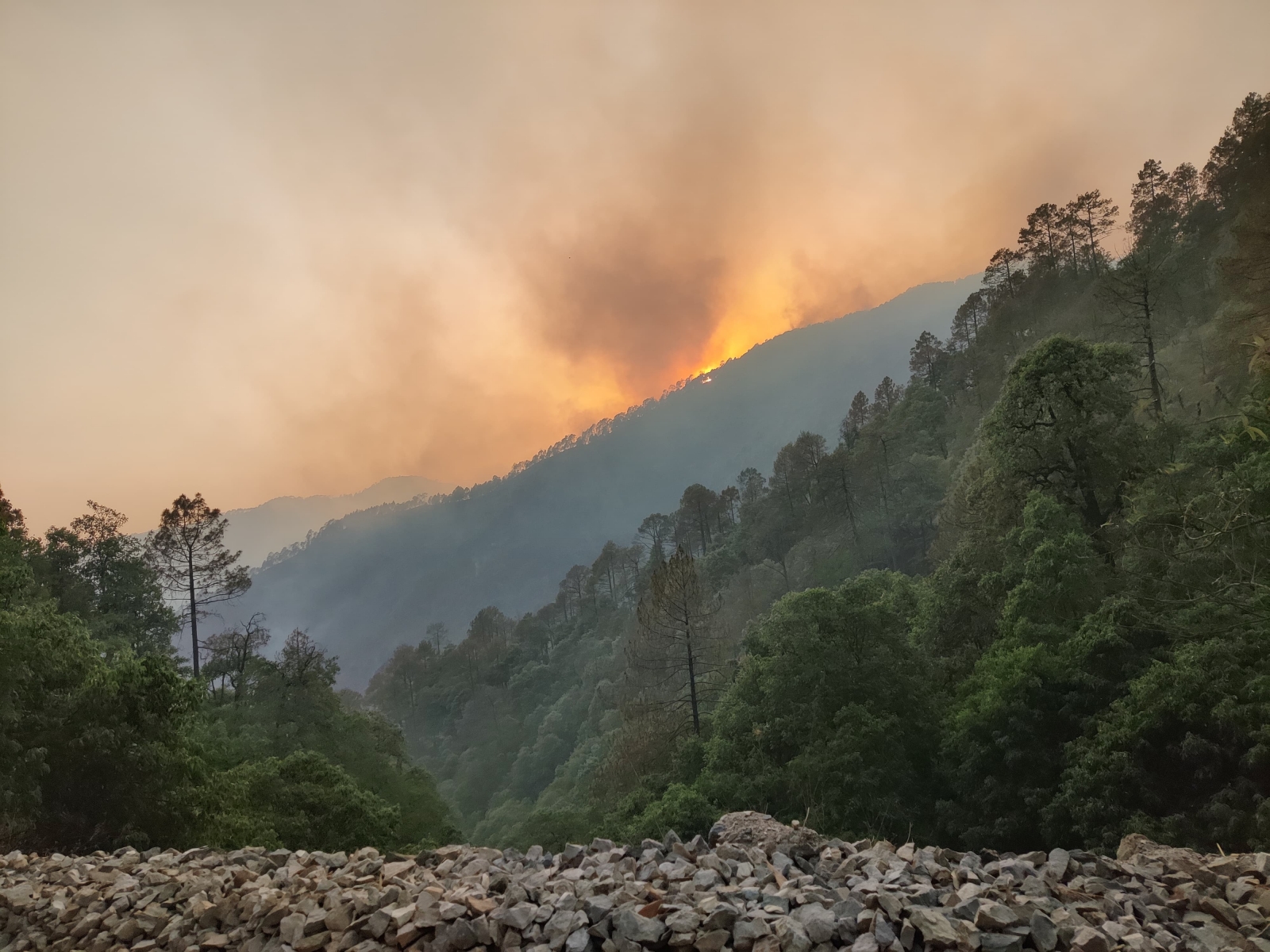Dousing a forest fire in Uttarakhand: A team of 11, 10 hours and an exploding pine cone
As Uttarakhand records close to 1,000 forest fires this year, The Indian Express accompanied a forest team as they worked to put out a blaze
 A forest fire on a hill in the Dhumakot area of Uttarakhand’s Pauri Garhwal district. The state has seen 998 incidents of forest fires since November 2023. (Express Photo by Avaneesh Mishra)
A forest fire on a hill in the Dhumakot area of Uttarakhand’s Pauri Garhwal district. The state has seen 998 incidents of forest fires since November 2023. (Express Photo by Avaneesh Mishra)“This is why it’s called ‘jungle ki aag ki tarah failna (spreading like wildfire)’…. Look how fast it’s spreading,” says Forester Shiv Singh Rawat, dashing towards a plume of fire that’s now racing down the slope like molten lava, inching dangerously close to a pile of pine needles.
Armed with only a branch to beat out the flames, Rawat, his sweat-soaked khaki uniform clinging to his body, climbs up the slope that’s strewn with pine needles. As he leads the charge, another forest guard follows closely behind, using a gardening rake to widen the gap between the fire and the surrounding vegetation.
The fire, in the upper reaches of a hill in the Dhumakot area of Uttarakhand’s Pauri Garhwal district, is among the latest of 998 incidents of forest fires recorded by the state’s forest department since November 2023 – 68 of those between May 6 and 7 alone. Last season, the state recorded 773 such fires.
The fires have so far affected 1,196 hectares of forest land, led to reports of wild animals encroaching into residential areas, and claimed four lives. The once lush hillsides of Pauri now stand scarred with charred, blackened patches.
Who started the fire?
According to the forest department, the cause of Uttarakhand’s forest fires are almost entirely man-made. However, the prolonged dry spell so far this year and lack of snowfall last winter may have contributed to favourable conditions for the fire to spread faster and to wider areas this year.
The summer months are when pine trees shed their needles, carpeting entire slopes and rooftops. When left uncleared, the needles turn slippery, making uphill climbs difficult. Villagers are known to set fire to pine needles to clear pathways and fields.
 The fires have so far affected 1,196 hectares of forest land, led to reports of wild animals encroaching into residential areas, and claimed four lives. (Express Photo: Avaneesh Mishra)
The fires have so far affected 1,196 hectares of forest land, led to reports of wild animals encroaching into residential areas, and claimed four lives. (Express Photo: Avaneesh Mishra)
“Almost all of the forest fires here are anthropogenic (caused by human activity). In some cases, the fires are the result of negligence, like when someone discards a burning cigarette or bidi. But in many cases, the fires are intentional, especially when villagers attempt to clear an area of pine needles, but the fire spreads to the nearby forested areas. There’s also a misconception that burning pine needles is good for fodder grass. Some even believe that the smoke from these fires brings better rains,” says Divisional Forest Officer (DFO) Swapnil Aniruddha.
Earlier in the day, the district forest officials had received an alert from the Dehradun-based Forest Survey of India (FSI) about the fire in the Dhumakot area. Led by DFO Swapnil, a team of 11 personnel, including Forest Range Officer Subhash Ghildiyal, a forester and forest guards, had rushed to the spot after extinguishing a fire in a nearby area. The fire, allegedly sparked by a farmer’s attempt to clear stubble on his farm, had quickly spread to the nearby forest.
After several tense minutes, the fire at Dhumakot is finally contained within three-metre-wide fire lines on either side. Fire lines, crucial in firefighting operations, serve as barriers to impede the fire’s advance. However, the fight is far from over. The team has to channel the fire down towards a concrete road but needs to make sure that the dry leaves and the layers of pine needles around the fire line don’t catch fire. The high temperatures and the blinding smoke make their job tougher.
“This year, the Indian Air Force deployed some helicopters to douse the fires, but given the number of fires, their help was limited. The bucket used by the helicopters is not that big, and so the choppers have to make several rounds to douse a fire,” says the DFO.
Forest officials, he explains, primarily rely on three strategies to douse fires. Besides constructing fire lines and quelling ‘creeping fires (the kind that smoulders below the surface)’, they occasionally initiate a ‘counter fire’, a blaze in the direction opposite to the advancing blaze.
‘Fires are a daily occurrence’
Around 9.30 pm, as the fire approaches the concrete road that is supposed to act as a natural firebreak, the team members breathe easy for the first time since they began their operation. Suddenly, a flaming pine cone explodes, reigniting the fire. The battle begins again.
“Our forest staff have been doing this for days. The heat is unbearable and they have to put up with the dense smoke. Many of my team members have had difficulty breathing and some have been complaining of irritation in the eyes,” says Swapnil.
As he navigates a slippery slope, gesturing to a forest guard to look for signs of creeping fires, the DFO explains, “The last rainfall we experienced was on March 3. Since then, there hasn’t been any rain, which is highly unusual. This year, there was also no snowfall, so the moisture content in the soil and leaf litter is significantly lower. This has made the entire area prone to forest fires. We have been firefighting since mid-February. But now the fires have become a daily occurrence. Most of us have been putting in around 16 hours of work a day.”
 forest fire on a hill in the Dhumakot area of Uttarakhand’s Pauri Garhwal district. (Express Photo: Avaneesh Mishra)
forest fire on a hill in the Dhumakot area of Uttarakhand’s Pauri Garhwal district. (Express Photo: Avaneesh Mishra)
Back in Dhumakot, around 11 pm, Rawat and his team finally manage to extinguish the fire. They gather on a small hillock, away from the dense plumes of smoke, to catch their breath and take cautious sips off their water bottles.
“We are running out of water. When we are out tackling forest fires, we can’t carry too much equipment with us. We bring a few water bottles, gardening rakes and torches. The helmets we have are useless against loose rocks, and we don’t have goggles or masks. Sometimes, we have to create fire lines that stretch on for 2-3 kilometers, which means inhaling smoke for 6-7 hours straight,” says Rawat.
An additional risk, he says, is of boulders expanding due to the intense heat from the fires and dislodging. Last week, several firefighters were injured in one such incident in Pauri. Also, a worker recently suffered 22 per cent burns when he was caught in a fire at the Rajaji National Park.
As the team prepares to leave, Range Officer Ghildiyal says the fires will have larger environmental consequences for the region. “With the grass and pine needles depleted, there’ll be nothing to retain rainwater. That will lead to flash floods, soil erosion, and landslides. Nearby water sources are already dwindling due to these fires. We hope for greater public involvement and strict deterrence from the government,” he says.
 Villagers clearing pine needles which are sold to units that convert them into biomass pellets and briquettes
Villagers clearing pine needles which are sold to units that convert them into biomass pellets and briquettes
Rs 3 for a kg of pine needles
The following morning, a group of seven women, enlisted by the forest department team from villages nearby, clear pine needles from a spot near the site of the fire. They sweep the needles off the ground and tie them into bundles, which will be sold to units that convert the pine needles into biomass pellets and briquettes.
Manju Devi, one of the women gathering the needles, says that they sell the needles for Rs 3 per kg, earning up to Rs 1,500 a day during the season.
Subhash Chandra, a retired IFS officer who owns Diva Briquettes around 4 km from Dhumakot, says, “This year, with forest fires destroying pine needles, we have been operating at less than half our production capacity of around 30 tonnes a day. Last year, during this season, we received around 200 quintals of raw material (pine needles) a day; this year, we have hardly been getting 50 quintals.”
- 01
- 02
- 03
- 04
- 05































